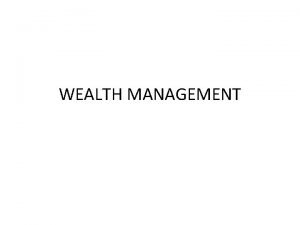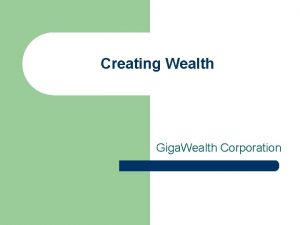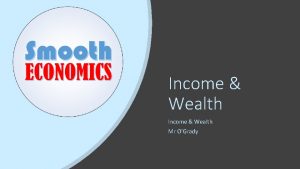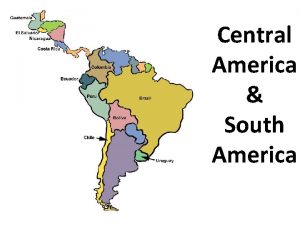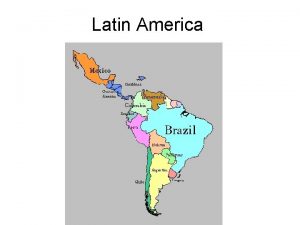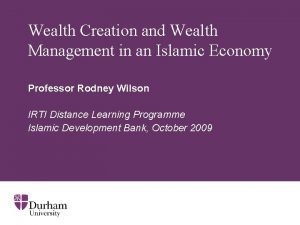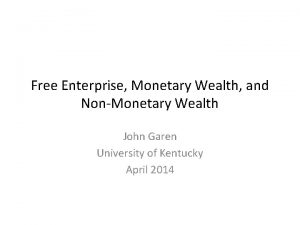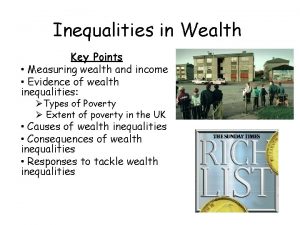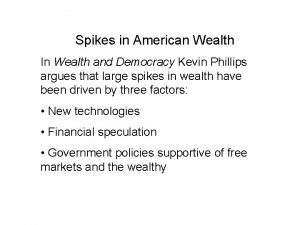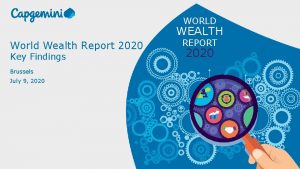Wealth and Access in America Wealth in the




























- Slides: 28

Wealth and Access in America

Wealth in the U. S. is shifting due to growing economic inequality and generational transfer, among other factors. What challenges and opportunities does this reality pose for independent schools?

Growing Economic Inequality The sources of the economic inequality “In the U. S. , 75. 4% of all wealth is owned by the richest 10%. ” “In the 1980 s, economic inequality began to rise, a result of globalization, technological change, government policies favoring the well-off and a slowdown in educational attainment and the work force’s skill level … [pinching] the incomes of the middle class and the poor. The tech boom of the 1990 s helped — slowing the decline of the American dream — but only temporarily. ” David Leonhardt, “The American Dream, Quantified This compares with – Australia, 50. 3%, – Canada, 57. 4%, – Denmark, 72. 2%, – Finland, 44. 9%, – France, 51. 8%, – Germany, 61. 7%, – Ireland, 58. 4%, and – Israel 68. 9%. at Last, ” The New York Times Eric Zuesse, “United States Is Now the Most Unequal of All Advanced Economies, ” The Huffington Post

Growing Economic Inequality is a bigger factor than the slowing of growth in the “fading American dream. ” “By itself, [the per capita GDP, almost twice as high as in 1980, ] should allow most children to live better than their parents. They don’t, however, because the fruits of growth have gone disproportionately to the affluent. … Given today’s high tech, globalized economy, the single best step would be to help more middle- and lowincome children acquire the skills that lead to good-paying jobs. ” Chance of making more money than your parents if you were … 92% Born in 1940 79% Born in 1950 62% 61% Born in 1960 Born in 1970 David Leonhardt, “The American Dream, Quantified at Last, ” The New York Times 50% Born in 1980

Cost Trends Compound the Inequality Soaring costs of education, child care, and health care “The same global economic trends that have helped drive down the price of most goods also have limited the well paying industrial jobs once available to a huge swath of working Americans. And the cost of many services crucial to escaping poverty — including education, health care and child care — has soared. ” Annie Lowrey, “Changed Life of the Poor: Better Off, but Far Behind, ” The New York Times Prices “rising on the very things … essential for climbing out of poverty” • “A college education has become a necessary passport to financial stability. • “It’s hard to hold a job if you’re chronically ill. • “Working full time is difficult if you can't pay somebody to watch your child. ” Jordan Weissmann, “Why Poverty Is Still Miserable, Even if Everybody Can Own an Awesome Television, ” Slate

Generational Wealth Transfer Wealth shift will peak starting in 2031 and will add to inequality. $24 trillion “When that process [of the wealth transfer from Baby Boomers to Gen X and Y] is Amount that will be underway, 10 percent of the country’s total wealth will change hands every five transferred in bequests years through inheritances, estates, gifts. . over the next 15 years Val Srinivas and Urval Goradia, And as income and wealth have become “The Future of Wealth in the distributed less evenly, the inherited United States, ” Deloitte spoils will be distributed unevenly, too. ” University Press Annie Lowrey, “What Comes After Rich Baby Boomers? Kids With a Big Inheritance, ” The New York Times Magazine

Other Wealth Trends Women acquiring more wealth through inheritance, divorce, and successful business “Women now control $39. 6 trillion, or about 30% of the world’s wealth — up from 25% held five years ago. … [Estimates are that] by 2020 women will control $72. 1 trillion globally. ” Megan Leonhardt, “Women’s Wealth Growing Faster Than Men’s, ” Time. com Geographic concentration of wealth “There are 12. 3 million households that earn more than $150, 000 a year — about three times the median household income in America. These households, which represent approximately the top 10 percent of earners, are heavily concentrated around the coasts and a few major landlocked cities. ” Chris Wilson, “How Many Rich People Live Near You? ” Time. com

Financial Realities and Spending/Saving Habits of Millennials As Millennial parents earn/inherit wealth, how will their debt and spending/saving habits impact how they invest in education? • • $1. 2 trillion Saddled with student debt Student loan debt owed by Feeling lasting effects of sluggish economy Americans as of Jan. 2016 Delaying home ownership Jillian Berman, “America’s Delaying/opting out of having families growing student-loan-debt crisis, ” Market. Watch. com Interested in saving & financial planning Reliant on parents Engaged with causes, not institutions Want their children to feel unique NAIS, “Looking Ahead: Millennials”

The College/University Picture Economic inequality reflected at colleges and universities “Students at elite colleges are even richer than experts realized. …” Despite an expansion of eligibility for Pell Grants, “the students at elite colleges, at least as of 2013, were not actually much more economically diverse than in the past, though there are some exceptions. ” “Some Colleges Have More Students From the Top 1 Percent Than the Bottom 60. Find Yours, ” The New York Times “ 38 colleges had more students from the top 1 percent than the bottom 60 percent. ”

The College/University Picture Are top colleges really committed to access? “Colleges often promote … their commitments to affordability. But some elite colleges have focused more on being affordable to low income families than on expanding access. … ‘Free tuition only helps if you can get in, ’ [said one of the authors of the study]. ” “Some Colleges Have More Students From the Top 1 Percent Than the Bottom 60. Find Yours, ” The New York Times Two elements of access “Arguments around highly selective colleges’ commitment to socioeconomic access demonstrate that the issue is twofold: You need to have funding to support the economic commitment to access. But you also need to shape the enrollment process to open that door wider. You can solve one problem and still have the other. ” Interview With Mark Mitchell, School and Student Services (SSS by NAIS)

The College/University Picture A path to prosperity “Lower income students who attend an elite university have nearly the same chance of reaching the upper middle class as do their better heeled peers. ” The Economist, “How Colleges Affect Social Mobility in America” Why college matters for mobility. 1. “College drop outs have average earnings levels and unemployment rates closer to that of high school graduates than college graduates. 2. “Individuals born into families at the bottom of the income distribution who get a college degree have more upward mobility than those who do not. … 3. “Parents pass on their educational advantage to the next generation. Almost half of the children born to fathers in the top quintile of educational attainment … are in the top quintile themselves as adults. ” Joanna Venator and Richard V. Reeves, “Three Reasons College Matters for Social Mobility, ” The Brookings Institution

The College/University Picture There are many (25– 30 K) highly qualified lowincome students colleges are not reaching. “There are missed opportunities in both directions: few if any of these students consider selective colleges, and selective colleges in turn miss them because they tend to focus their outreach efforts in major cities, whereas many of these low income, high achieving students live in non major urban areas. “The research has implications for how selective universities conduct recruitment and ultimately whether they simply focus on having a student body that is racially diverse or one that is more broadly income diverse. ” Caroline M. Hoxby and Christopher Avery, “The Missing ‘One-Offs’: The Hidden Supply of High-Achieving, Low Income Students, ” The Brookings Institution

The College/University Picture 30 public & private colleges/ universities pledge to recruit more low-income students. “Calling their alliance the ‘American Talent Initiative, ’ … the schools declared that their goal is to enroll an additional 50, 000 [high achieving students with significant financial need] at 270 selective colleges and universities by 2025, [a 12 percent increase]. ” Nick Anderson, “Selective Colleges Pledge to Recruit More Low-Income Students, ” The Washington Post A commitment by leadership “Although it’s too soon to see results, the pledge is a good example of schools recognizing there is a problem to solve. It’s also important from a leadership perspective: The participating schools would not be on this list without a thumbs up from their presidents and boards. ” Interview With Mark Mitchell, School and Student Services (SSS by NAIS)

The Public School Picture Public schools still segregated “[Despite the Brown v. Board of Education decision in 1954, ] we don’t see real desegregation occurring in this country until 1964. . [Then, in 1988, ] we reach kind of the peak of schools integrating, of black students attending majority white schools at the highest rates that they ever have in the country, and then we start to see school districts re-segregating, which means black students are starting to go to schools that are more and more segregated. And school districts that had a degree of integration are losing that integration. ” NPR Fresh Air Interview with Nikole Hannah-Jones, “How the Systemic Segregation of Schools Is Maintained by ‘Individual Choices’”

The Public School Picture Socioeconomic integration picking up momentum “Last year, New York State launched a program to promote economic diversity at low performing schools, while districts like Denver have recently tried to create more integrated schools through choice based lottery systems. The U. S. Department of Education is also entering the debate, and is looking to promote efforts that build economic diversity. ” Impact on all students “Low income students who attend more affluent schools boost their chances of attending college by almost 70 percent. … The learning of more affluent students generally tends to hold steady in more diverse schools. ” Ulrich Boser, “Separate and Economically Unequal, ” U. S. World & News Report

The Independent School Picture Many families still feeling financially insecure “Participation in the labor force remains below pre recession levels, and real wages have stagnated. … Finally, the recovery of the stock market has largely benefited high income families, widening the gap between upper and middle income families. … Many families, even some high income families … may be questioning their ability to afford an independent school. ” Widening gap between middleand upper-income family wealth Source: Richard Fry and Rakesh Kochhar, “America’s Wealth Gap Between Middle Income and Upper Income Families Is Widest on Record, ” Pew Research Center (Chart as it appeared in the Trendbook) Amada Torres, “The Economic Outlook, ” 2015– 2016 NAIS Trendbook

The Independent School Picture Tuition has outpaced wealth growth. “Even in the case of upper income families, [independent school] tuition increases outpaced wealth growth during the period 1983– 2013 [when] median tuition averaged across all grades at day and boarding schools grew by nearly 150 percent. Furthermore, tuitions at independent schools increased consistently since 1983, even during the recession years. ” Amada Torres, “The Economic Outlook, ” 2015– 2016 NAIS Trendbook

The Independent School Picture Schools awarding less of financial aid budget to lower-income families “Five year trends in the number of applications for aid and the number of awards suggest … that increasing awards for families with higher incomes has come at the cost of offering fewer awards to the lowest income families seeking to gain access to the independent school. ” Mark Mitchell and Melvin Rhoden, “The Financial Aid Outlook, ” 2015– 2016 NAIS Trendbook

Implications for Schools

Impact of Change in Wealth on Schools Admission/Enrollment • General feeling of financial insecurity making independent education seem like a bigger investment for families • New school options giving parents a choice for perceived value at a lower cost • More grandparents paying tuition and therefore becoming an even more important constituency • Even more influence by women in the choice to invest in an independent education for their children • Differences in what’s important to Millennials (and the reality of their student debt) requiring a new look at the admission/enrollment approach

Impact of Change in Wealth on Schools Development • Current parents weaker giving targets due to the feeling of financial insecurity • Need for more focus on alumni giving • More opportunity with planned giving among Boomers and Silent Generation • Need to consider female giving patterns as wealth increases among women

Impact of Change in Wealth on Schools Commitment to Access/Socioeconomic Diversity • Fewer full pay prospective families makes committing to socioeconomic diversity and access even more complex in a tuition driven industry. At the same time, research shows that education is the #1 way to increase social mobility. • Concentration of wealth in neighborhoods where many independent schools are located means lower income families may have less exposure to independent schools and a bigger transportation hurdle to overcome.

School Efforts

Schools Attempting to Increase Access Despite Wealth Trends Lakeside School’s microschool will expand access. “The micro school would aim to preserve the fundamental component of Lakeside [(Washington)], a high quality academic education … more narrowly focusing on academics rather than providing a comprehensive slate of offerings; having somewhat larger class sizes … operating in a modest, leased space, and charging nearly 50 less for tuition. ” Lakeside School, “Board Approves Micro-School Concept, ” Lakeside Roland Park opened a charter school to be part of city’s educational solution. In 2008, the Baltimore City School Superintendent “‘challenged independent schools to be part of the solution, and we took that to heart, ’ said Nancy Mugele, assistant head of school for external relations at Roland Park Country School [(Maryland)]. ” Independent School magazine, “Roland Park Country School Set to Open Public Charter School”

Schools Attempting to Increase Access Despite Wealth Trends Winchendon School (Massachusetts) explores satellite campuses to curb costs and serve more students. Looking to sustain and strengthen their school, Winchendon’s head and board explored possibilities for new models/cost structures. The school serves many students who have struggled in other learning environments but then thrive in the school’s micro classes, taking advantage of experiential learning opportunities and the school’s individualized approach. “In 10 years, ” says Head of School John Kerney, “we hope to educate 10 times more Market research has led the school to consider opening satellite students at a campuses in urban markets where there is a dearth of schools significantly serving this population. The model would reduce overhead reduced cost to burden through lessening the campus footprint and by parents. ” centralizing many administrative services such as development, admissions, finance, and HR.

Schools Attempting to Increase Access Despite Wealth Trends Groton School affirms its commitment to affordability. “The GRoton Affordability and INclusion (GRAIN) initiative froze tuition for three years, increased the number of students on financial aid, and guaranteed that Groton School [(Massachusetts)] would consider all applicants without regard to their ability to pay. ” Groton School website

Schools Attempting to Increase Access Despite Wealth Trends Prep@Pingree builds skills and relationships. The school’s broad commitment to access: “Access also means being able to get to school, athletics games, “The 12 month Malcolm Coates service events, and arts Prep@Pingree program [at Pingree performances, no matter where School (Massachusetts)] seeks to you live. It means our students enrich the lives of students from Lawrence, Lynn, and other communities have exposure to the tools, resources, and support who have completed their 7 th grade academic year by providing academic, services that they need to thrive. cultural, and social opportunities for five Opportunities for travel, civic engagement, and co curricular weeks during the summer and exploration are available to all who periodically throughout the year. ” walk these halls, expenses Pingree School website notwithstanding. ”

Resources • • • • • • • David Leonhardt, “The American Dream, Quantified at Last, ” The New York Times Eric Zuesse, “United States Is Now the Most Unequal of All Advanced Economies, ” The Huffington Post Annie Lowrey, “Changed Life of the Poor: Better Off, but Far Behind, ” The New York Times Jordan Weissmann, “Why Poverty Is Still Miserable, Even if Everybody Can Own an Awesome Television, ” Slate Annie Lowrey, “What Comes After Rich Baby Boomers? Kids With a Big Inheritance, ” The New York Times Magazine Val Srinivas and Urval Goradia, “The Future of Wealth in the United States, ” Deloitte University Press Megan Leonhardt, “Women’s Wealth Growing Faster Than Men’s, ” Time. com Chris Wilson, “How Many Rich People Live Near You? ” Time. com NAIS, “Looking Ahead: Millennials” Jillian Berman, “America’s growing student-loan-debt crisis, ” Market. Watch. com “Some Colleges Have More Students From the Top 1 Percent Than the Bottom 60. Find Yours. ” The New York Times Interview With Mark Mitchell, School and Student Services (SSS by NAIS) The Economist, “How Colleges Affect Social Mobility in America” Joanna Venator and Richard V. Reeves, “Three Reasons College Matters for Social Mobility, ” The Brookings Institution Caroline M. Hoxby and Christopher Avery, “The Missing ‘One-Offs’: The Hidden Supply of High-Achieving, Low Income Students, ” The Brookings Institution Nick Anderson, “Selective Colleges Pledge to Recruit More Low-Income Students, ” The Washington Post NPR Fresh Air Interview With Nikole Hannah-Jones, “How the Systemic Segregation of Schools Is Maintained by 'Individual Choices’” Ulrich Boser, “Separate and Economically Unequal, ” U. S. News & World Report Amada Torres, “The Economic Outlook, ” 2015– 2016 NAIS Trendbook Mark Mitchell and Melvin Rhoden, “The Financial Aid Outlook, ” 2015– 2016 NAIS Trendbook Lakeside School, “Board Approves Micro-School Concept, ” Lakeside “Roland Park Country School Set to Open Public Charter School, ” Independent School magazine San Francisco School website, www. SFSchool. org Groton School website, www. Groton. org Pingree School website, www. Pingree. org
 Rap of the map of the us
Rap of the map of the us America 2 europe
America 2 europe Repetition in let america be america again
Repetition in let america be america again Why called latin america
Why called latin america Happening e performance
Happening e performance Terminal access controller access control system
Terminal access controller access control system Terminal access controller access-control system
Terminal access controller access-control system Hát kết hợp bộ gõ cơ thể
Hát kết hợp bộ gõ cơ thể Slidetodoc
Slidetodoc Bổ thể
Bổ thể Tỉ lệ cơ thể trẻ em
Tỉ lệ cơ thể trẻ em Gấu đi như thế nào
Gấu đi như thế nào Tư thế worm breton là gì
Tư thế worm breton là gì Chúa yêu trần thế alleluia
Chúa yêu trần thế alleluia Môn thể thao bắt đầu bằng từ đua
Môn thể thao bắt đầu bằng từ đua Thế nào là hệ số cao nhất
Thế nào là hệ số cao nhất Các châu lục và đại dương trên thế giới
Các châu lục và đại dương trên thế giới Cong thức tính động năng
Cong thức tính động năng Trời xanh đây là của chúng ta thể thơ
Trời xanh đây là của chúng ta thể thơ Mật thư anh em như thể tay chân
Mật thư anh em như thể tay chân Phép trừ bù
Phép trừ bù độ dài liên kết
độ dài liên kết Các châu lục và đại dương trên thế giới
Các châu lục và đại dương trên thế giới Thể thơ truyền thống
Thể thơ truyền thống Quá trình desamine hóa có thể tạo ra
Quá trình desamine hóa có thể tạo ra Một số thể thơ truyền thống
Một số thể thơ truyền thống Cái miệng xinh xinh thế chỉ nói điều hay thôi
Cái miệng xinh xinh thế chỉ nói điều hay thôi Vẽ hình chiếu vuông góc của vật thể sau
Vẽ hình chiếu vuông góc của vật thể sau Nguyên nhân của sự mỏi cơ sinh 8
Nguyên nhân của sự mỏi cơ sinh 8





























